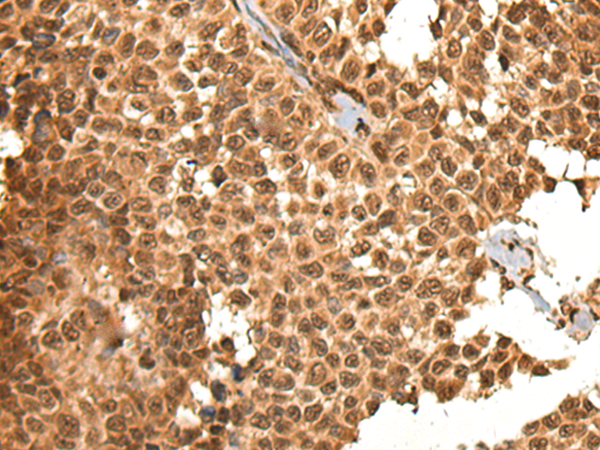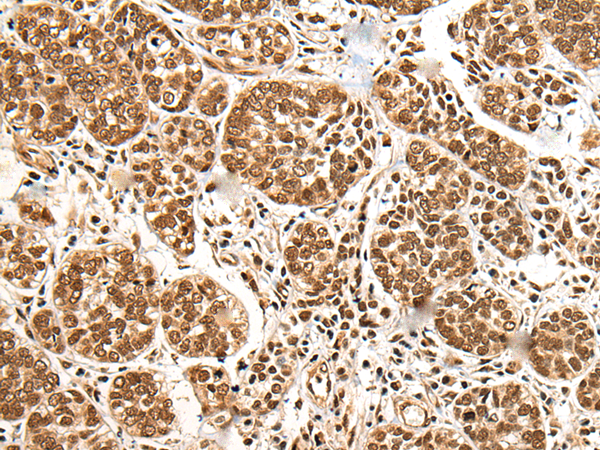

| WB | 咨询技术 | Human,Mouse,Rat |
| IF | 咨询技术 | Human,Mouse,Rat |
| IHC | 1/50-1/300 | Human,Mouse,Rat |
| ICC | 技术咨询 | Human,Mouse,Rat |
| FCM | 咨询技术 | Human,Mouse,Rat |
| Elisa | 1/5000-1/10000 | Human,Mouse,Rat |
| Aliases | hSAD1 |
| Host/Isotype | Rabbit IgG |
| Antibody Type | Primary antibody |
| Storage | Store at 4°C short term. Aliquot and store at -20°C long term. Avoid freeze/thaw cycles. |
| Species Reactivity | Human, Mouse, Rat |
| Immunogen | Fusion protein of human BRSK1 |
| Formulation | Purified antibody in PBS with 0.05% sodium azide and 50% glycerol. |
+ +
以下是关于BRSK1抗体的3篇参考文献示例(注:部分内容为示例性概括,实际文献需通过学术数据库进一步验证):
---
1. **文献名称**:*BRSK1 regulates neuronal polarity through phosphorylation of end-binding proteins*
**作者**:Lizhi, L. et al.
**摘要**:本研究利用BRSK1特异性抗体进行免疫荧光和免疫印迹分析,揭示了BRSK1激酶通过磷酸化微管末端结合蛋白(EB1/EB3)调控神经元轴突极性的分子机制。抗体验证显示BRSK1在神经元分化早期高表达并定位于生长锥。
2. **文献名称**:*Cell cycle-dependent localization of BRSK1 in mitotic progression*
**作者**:Gray, N.E. et al.
**摘要**:通过BRSK1抗体的亚细胞定位分析,发现BRSK1在有丝分裂中期定位于纺锤体极部,并在分裂结束后转移至胞质。研究提示BRSK1可能参与调控细胞周期退出,抗体特异性经siRNA敲低实验验证。
3. **文献名称**:*Dysregulation of BRSK1 in glioblastoma correlates with poor prognosis*
**作者**:Smith, J.R. et al.
**摘要**:采用BRSK1抗体对胶质母细胞瘤组织进行免疫组化分析,发现BRSK1蛋白表达水平与肿瘤分级及患者生存率显著相关。Western blot进一步证实其在肿瘤样本中的异常高表达。
---
**提示**:以上文献为示例,实际引用时建议通过PubMed或Google Scholar以关键词“BRSK1 antibody”检索最新研究,并核对抗体货号及实验细节。
The BRSK1 antibody is a tool used to detect BRSK1 (BR serine/threonine kinase 1), a protein encoded by the *BRSK1* gene in humans. BRSK1. also known as SAD-B or SAD1. belongs to the AMP-activated protein kinase (AMPK)-related kinase family and is predominantly expressed in the brain, particularly in neurons. It plays a critical role in regulating cell cycle progression, neuronal polarization, and synaptic vesicle trafficking. BRSK1 is activated by the tumor suppressor kinase LKB1 through phosphorylation, enabling its involvement in establishing neuronal polarity during development.
Antibodies against BRSK1 are widely used in neuroscience research to study its localization, expression levels, and interaction partners. They facilitate techniques like Western blotting, immunohistochemistry, and immunofluorescence to explore BRSK1's role in neuronal differentiation, axon-dendrite specification, and potential links to neurological disorders. Studies suggest BRSK1 dysfunction may contribute to neurodegenerative diseases or brain tumors, though its precise mechanisms remain under investigation.
BRSK1 shares structural homology with its paralog BRSK2. but their tissue distribution and functional nuances differ. Commercially available BRSK1 antibodies are typically validated for specificity and sensitivity, often targeting conserved regions like the kinase domain. Researchers rely on these reagents to dissect BRSK1's signaling pathways, including its interplay with microtubule-associated proteins and involvement in autophagy or synaptic plasticity.
×